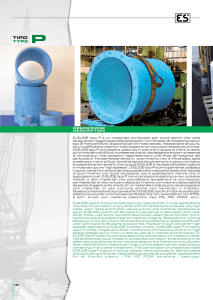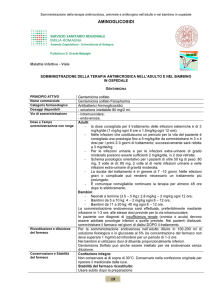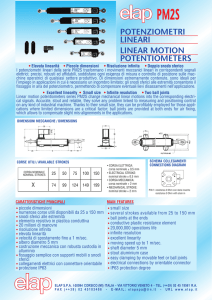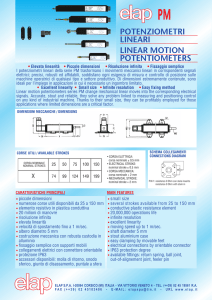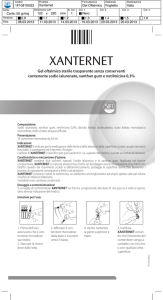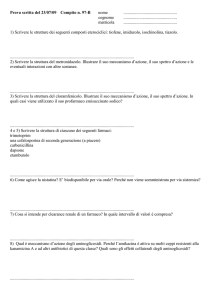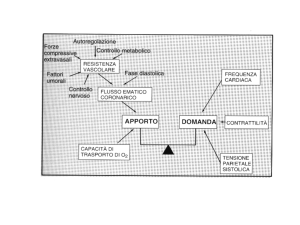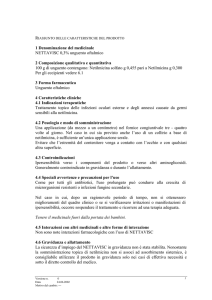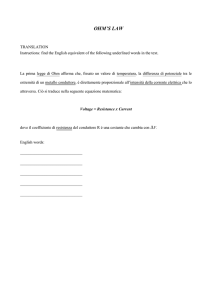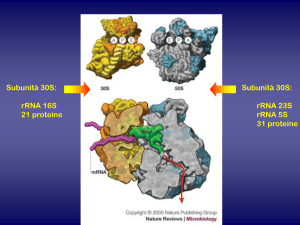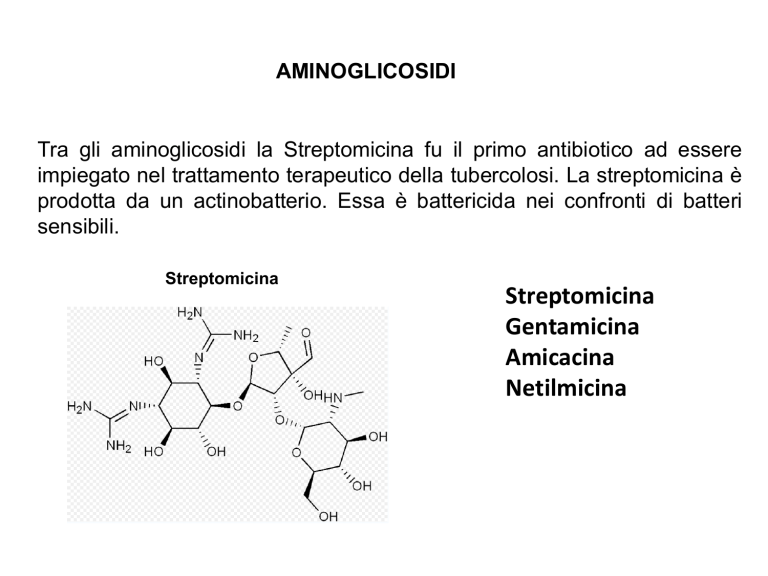
AMINOGLICOSIDI
Tra gli aminoglicosidi la Streptomicina fu il primo antibiotico ad essere
impiegato nel trattamento terapeutico della tubercolosi. La streptomicina è
prodotta da un actinobatterio. Essa è battericida nei confronti di batteri
sensibili.
Streptomicina
Streptomicina
Gentamicina
Amicacina
Netilmicina
Struttura e caratteristiche chimiche
Sono delle basi deboli solubili in acqua.
Sono policationi a pH corporeo e passano in quantità ridotte la
membrana cellulare.
Provengono da:
Micromonospora actinomyctes
Gentamicina (gentamicin and netilmicin)
Streptomyces griseus
Streptomicina (streptomicina e diidrostreptomicina)
Kanamicina (kanamycina, amikacina, e tobramicina)
Neomicina (neomicina)
Apramicina (farmaco veterinario)
For Waksman the discovery of streptomycin in 1944 and
its effect on the tubercle bacillus accomplished with the
collaboration of A. Schatz and confirmation by E. Bugie
was a rich and satisfying fulfillment of many of his
personal and altruistic aims. Ever practical, he
established effective and congenial relations with Merck
and Company, which developed liquid culture methods
for production of bulk quantities of the microbial
products during World War II. Patenting and licensing the
promising ones, notably streptomycin, provided funds,
80 percent of which was assigned to Rutgers University
to support research and eventually an associated
Institute of Microbiology. He also soon arranged to have
animal tests and clinical trials carried out at the Mayo
Clinic to expedite the possible use in treating
tuberculosis. Of the 20 percent of license funds accruing
in his own name, one-half was later consigned to a
foundation for research support.
The first clinical trial with a randomized intake in the history of medicine was
started in 1946 by the British Medical Research Council (13). Because only a
limited amount of SM was available in the United Kingdom, patients with
advanced pulmonary disease could ethically be randomized to treatment with
bed rest alone or bed rest plus 2 g SM daily. The results (Table 1) showed a
substantial immediate advantage to the SM arm, but most patients developed
Sm/resistant strains, and the results of a 5-year follow-up indicated that they had
little eventual benefit compared with the control arm.
The major historical landmarks of tuberculosis (TB)
therapy include: the discovery of effective
medications (streptomycin and para-aminosalicylic
acid) in 1944; the revelation of "triple therapy"
(streptomycin, para-aminosalicylic acid and isoniazid)
in 1952, which assured cure; recognition in the 1970s
that isoniazid and rifampin could reduce the duration
of treatment from 18 to 9 months; and the
observation in the 1980s that adding pyrazinamide to
these drugs allowed cures in only 6 months.
Spettro d’azione
- Altamente efficaci nei confronti di bacilli gram
negativi
- Efficaci (Netilmicina) contro lo stafilococco
meticillino resistente
- Meno efficaci nei confronti dei cocchi gram negativi
P.aeruginosa: gentamicina,tobramicina,
amikacina e netilmicina
- Resistenti agli enterococchi e Micobatteri anaerobi:
streptomycin, kanamycin
E.Coli
Klebsiella
Aerobic. Most common cause of urinary
tract infection in young women. Causes
cystitis, pyelonephritis, sepsis, neonatal
meningitis, and enteric diseases.
Enterohemorrhagic E. coli causes
hemolytic uremic syndrome, and
enterotoxigenic E. coli causes travelers
diarrhea.
aerobic
(faculatative
anaerobe)
encapsulated Causes pneumoniae (thick
bloody sputum) and urinary tract
infection.The
autoimmune
disease,
ankylosing spondylitis, is thought to be a
possible sequela of Klebsiella infection.
Meccanismo di azione
Gli
aminoglicosidi
inibiscono la sintesi
proteica
alla
legandosi
porzione
rRNA
16S
del ribosoma
batterico interferendo
con il legame della
FORMILMETHIONYL-tRNA
nelle subunità 30S.
Questo
impedisce
l’inizio della sintesi
proteica portando a
morte
le
batteriche.
cellule
Formylmethionyl-tRNA, fMet-tRNA et, plays a key
role in the initiation of bacterial protein synthesis,
acting as the donor of the NH2-terminal amino acid
of the nascent polypeptide chain. A regulatory
function for this tRNA was recently suggested by the
observation of its binding to Escherichia coli RNA
polymerase holoenzyme; this is a specific interaction
that requires both the formyl and tRNA moieties.
USI “STORICI” DELLA STREPTOMICINA
• Nella
tubercolosi viene usata in combinazione con altre farmaci antiTB. Non è il trattamento di scelta.
• Nella peste (Yersinia pestis), è stata storicamente trattata con la
streptomicina che è il farmaco di scelta e approvata per questa finalità
dalla FDA americana.
• Nelle endocarditi infettive causate da enterococchi quando
l’organismo non è sensibile alla Gentamicina.
• Nella medicina veterinaria, la streptomicina è il primo antibiotico
usato contro i batteri gram negativi in grandi animali come cavalli,
pecore e bovini. E’ comunemente combinata alla penicillina-g per
iniezioni intramuscolo.
• Generalmente la streptomicina viente somministrata per via
intramuscolare (in molti paesi è auturozzata la sola somministrazione
intramuscolo). Il farmaco però può essere somministrato anche per via
endovenosa.
Meccanismi di resistenza
1) Produzione di enzimi che
inattivano gli aminoglicosidi per
adenililazione, acetilazione e
fosforilazione
2) Incapacità di entrare nella cellula
batterica
3) Target proteico alterato
Resistenza batterica agli aminoglicosidi
Tossicita’
The aminoglycosides can be ranked in order of decreasing
toxicity: neomycin> amikacin > gentamicin > tobramycin >
netilmicin.
Differences in nephrotoxic potential are related to
increased ability to bind to the brush border membranes
of the renal tubule. Experimental and clinical studies have
shown that the relative risk of developing auditory
toxicity from gentamicin and tobramycin is generally
considered to be equivalent.
Effetti collaterali
1) Ototossicità
Danno cocleare: tinnito e perdita dell’udito
Danno vestibolare: vertigini atassia e
perdita della postura
2) Nefrotossicità (si manifesta attraverso la
proteinuria)
3) Blocco neuromuscolare (in particolare dato
dall’associazione con la neostigmina e
gluconato di calcio)
4) Reazioni allergiche
Fig. 1. Proposed mechanism of aminoglycoside (AG) toxicity at
the level of the hair cell in the cochlea and utricle of the inner
ear. After the AG enters the hair cell through mechano-electrical
transducer channels, it forms a complex with a transition metal,
in this case iron (Fe). These redox active complexes generate
ROS/RNS including the superoxide anion radical, hydrogen
peroxide, hydroxyl radical, peroxynitrite anion, etc. These
reactants activate JNK (c-Jun N-terminal kinase) which then
translocate (straus locates) to the nucleus to activate genes in the
cell death pathway; these products are then transferred to the
mitochondria (mito) where they promote the release of
cytochrome c (Cyt c). In the cytosol, Cyt c triggers the activation
of a series of caspases followed by apoptosis (programmed cell
death) via what is referred to as caspase-dependent cell death. In
addition to this caspase-dependent apoptotic pathway, AG may
also kill cells via caspase-independent mechanisms
Indian J Med Res 129, January 2009, pp 108-110
Correspondence
Sir,
Streptomycin (SM) has been used in the treatment of tuberculosis (TB) for more
than 50 years and is an important part of current treatment regimens for category II
pulmonary TB cases.
Due to its usage over a period of time and even as a monotherapy, resistance to
streptomycin has increased.
Globally, the range of initial and acquired streptomycin resistance has been
reported to be 0-51.5 and 0-73.1 per cent, respectively during the period 19992002.
Cloramfenicolo
Il cloramfenicolo è un antibiotico a largo spettro
d’azione che è usato largamente in applicazioni
topiche in oftalmologia e dermatologia.
Spettro d’azione
Meningiti
Psittacosi
Fibrosi cistica
Rickettiosi
Haemophilus influenzae
Limfogranuloma venereo
Salmonella
Febbre tifoide
Meccanismo di azione
Il cloramfenicolo è un farmaco liposolubile ed entra bene nella membrana
batterica legandosi irreversibilmente alla subunità 50s dei ribosomi batterici
dove impedisce il trasferimento di un aminoacido nella crescita proteica sia
negli organismi procariotici che nei mitocondri.
Effetti tossici
Gli effetti tossici possono ssere di natura:
1) Neurologica: Confusione, mal di testa
2) Oftalmici: Bruciore agli occhi
3) Psichiatrici: Depressione
4) Cardiaci: sindrome grigia del neonato, anemia aplastica
Resistenza batterica multipla
A conjugative plasmid, pMRV150, which mediated multiple-drug resistance (MDR) to
at least six antibiotics, including ampicillin, streptomycin, gentamicin, tetracycline,
chloramphenicol, and trimethoprim-sulfamethoxazole, was identified in a Vibrio
cholerae O139 isolate from Hangzhou, eastern China, in 2004.
Indian J Med Res. 2008 May;127(5):478-82.
Trend of antibiotic resistance of Vibrio cholerae strains from
East Delhi.
Das S, Saha R, Kaur IR.
Department of Microbiology, University College of Medical Sciences & Guru Teg Bahadur
Hospital, Shahdara, Delhi, India. [email protected]
Multiple antibiotic resistance (MAR) V. cholerae O1
Inaba isolates exhibited increased resistance to
ciprofloxacin with MIC >4 microg/ml, but largely all
remained susceptible to other antibiotics like,
gentamicin, tetracycline and chloramphenicol.
J Infect Dev Ctries. 2009 Feb 28;3(1):35-40.
Prevalence and antibiotic-resistance of Salmonella isolated from
food in Morocco.
Bouchrif B, Paglietti B, Murgia M, Piana A, Cohen N, Ennaji MM,
Rubino S, Timinouni M.
Laboratoire de Microbiologie et d'Hygiène des aliments et des eaux,
Institut Pasteur du Maroc, Morocco.
Salmonellosis remains one of the most frequent food-borne diseases
worldwide, especially in developing countries. The emergence of
antimicrobial resistance in Salmonella isolates from food can
potentially compromise the treatment of these infections.
Resistance to tetracycline was the most common finding (21%), followed by
resistance to ampicillin (13%), amoxicillin+clavulanic acid (9%), streptomycin
(7%), chloramphenicol (4%) and nalidixic acid (3,8%). None of the isolates
was resistant to 3rd-cephalosporin and fluoroquinolones (i.e. ciprofloxacin).
Magnitude of drug resistant Shigellosis: a report from Bangalore.
Srinivasa H, Baijayanti M, Raksha Y.
Department of Microbiology, St. John's Medical College, Bangalore - 560 034, India.
Shigella is an important cause of acute invasive diarrhea in children
and others.
The results also suggest that Ampicillin, Co-trimoxazole, Chloramphenicol,
Nalidixic acid and Ciprofloxacin should not be used empirically as the first line
drugs in the treatment of Shigellosis. Periodic analysis and reporting of
antibiotic susceptibility is an important measure to guide antibiotic treatment.
BMJ. 2009 Jan 15;338:a2812. doi: 10.1136/bmj.a2812. Links
Does single application of topical chloramphenicol to high risk sutured wounds reduce
incidence of wound infection after minor surgery? Prospective randomised placebo
controlled double blind trial.
Heal CF, Buettner PG, Cruickshank R, Graham D, Browning S, Pendergast J,
Drobetz H, Gluer R, Lisec C.
James Cook University, School of Medicine, Mackay Base Hospital, Queensland 4740,
Australia. [email protected]
Application of a single dose of topical chloramphenicol to high risk sutured wounds
after minor surgery produces a moderate absolute reduction in infection rate that is
statistically but not clinically significant
Interazione tra antibiotici
Antimicrob Agents Chemother. 2008 Nov;52(11):4172-4.
Inhibition of voriconazole metabolism by chloramphenicol in an
adolescent with central nervous system aspergillosis.
Hafner V, Albermann N, Haefeli WE, Ebinger F.
Department of Internal Medicine VI, Clinical Pharmacology and
Pharmacoepidemiology, University of Heidelberg, Heidelberg,
Germany.
For an adolescent with bacterial meningitis and subsequent
cerebral aspergillosis, intravenous voriconazole dose
requirements substantially decreased during coadministration
with intravenous chloramphenicol and considerably rose after
discontinuation of the antibiotic. In agreement with in vitro
evidence, these data suggest that chloramphenicol is a rather
significant inhibitor of hepatic CYP3A4 and/or CYP2C19.

